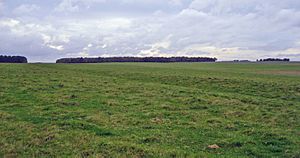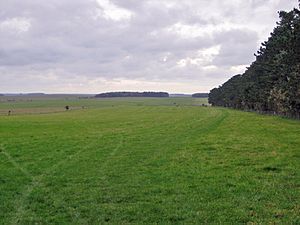Stonehenge Cursus facts for kids

The southern ditch and bank of the Cursus. It runs west to the gap in the trees.
|
|
|
Map showing the Cursus within the Stonehenge section of the Stonehenge and Avebury World Heritage Site
|
|
| Alternative name | Greater Cursus and Lesser Cursus |
|---|---|
| Region | Wiltshire |
| Coordinates | 51°11′10″N 1°49′34″W / 51.186°N 1.826°W |
| Type | Cursus |
| History | |
| Periods | Neolithic |
| Site notes | |
| Excavation dates | 1947, 2007 |
| Archaeologists | John FS Stone, Stonehenge Riverside Project |
| Condition | Excellent |
| Public access | Yes |
| Website | National Trust |
| Designated | 1986 |
| Reference no. | 373 |
| Designated | 1952 |
| Reference no. | 1009132 |
The Stonehenge Cursus is a very old and long earthwork (a shape made in the ground). It is found near Stonehenge in Wiltshire, England. People also call it the Greater Cursus. It was built during the Neolithic period, which was the New Stone Age.
This huge earthwork is about 3 kilometers (almost 2 miles) long. It is between 100 and 150 meters (330 to 490 feet) wide. Scientists used radiocarbon dating to find out when it was built. They found it was made between 3630 and 3375 BCE. This was hundreds of years before the first part of Stonehenge was built around 3000 BCE.
The Cursus is part of the Stonehenge and Avebury World Heritage Site. This means it is a very important historical place. The National Trust helps to look after it.
Contents
What Does 'Cursus' Mean?
The word "cursus" comes from a Latin word. It means 'racecourse'. Early archaeologists (people who study old things) first found these earthworks. They thought they might have been Roman racing tracks. But now we know they are much older.
Why Was the Cursus Built?
The Stonehenge Cursus was built a very long time ago. It was made between 3630 and 3375 BCE. This date was found by studying an red deer antler pick found in one of its ditches. The Cursus is just under 3 kilometers long. It is usually about 100 meters wide. But it gets wider near its western end, almost 150 meters wide.
The Cursus is mostly lined up from east to west. It points towards where the sun rises during the spring and autumn equinoxes. An equinox is when day and night are about the same length.
Inside the western end of the Cursus, there is a later Bronze Age round barrow (a burial mound). At its eastern end, there is a large Neolithic long barrow (another type of burial mound). The ditches of the Cursus are not all the same. Some are shallow, like the eastern and southern ditches. Others, like the western ditch, are deeper and wider.
We are not completely sure why the Cursus was built. But most experts think it was used for special ceremonies. It crosses a dry valley called Stonehenge Bottom. This valley might have had a stream during the Neolithic period. If so, it could have been important for ceremonies. Some people also think the Cursus was a boundary. It might have separated places where people lived from places used for ceremonies. The Cursus also lines up with the sunrise on the equinox over the eastern long barrow.
Two man-made pits have been found near the ends of the Cursus. The lines of sunrise and sunset during midsummer through these pits match up with Stonehenge. This suggests a connection between them.
Discovering the Cursus
William Stukeley was the first person to find and write about the Stonehenge Cursus. This was in the 1700s. However, he thought it was built by the Romans, which was incorrect.
In 1947, an archaeologist named John FS Stone dug a small part of the southern ditch. He found a tiny piece of bluestone and an antler pick. The antler pick was placed in a special spot and dated to about 2500 BCE.
Later, in 2007, the Stonehenge Riverside Project dug three more areas at the western end of the Cursus. They found another antler pick in the western ditch. In the northern ditch, they found a piece of pottery. This pottery might be from the 4th millennium BCE (4000-3001 BCE). They also found that the southern ditch had been dug again (or "recut") around 2500 BCE and then again between 2000 and 1500 BCE.
Amesbury 42 Long Barrow
Just past the eastern end of the Cursus is a Neolithic long barrow. This barrow is a long burial mound. It was first noticed by William Stukeley in 1723. Later, in 1868, John Thurnam dug there. He found an ox skull and some other burials.
Today, this barrow has been flattened. It is now under a bridleway (a path for horses and walkers). The ditch of this barrow was dug up again in the 1980s. But they didn't find anything that could be dated. In 2008, the Stonehenge Riverside Project dug the ditch once more.
Experts have suggested that this barrow should be better protected. They recommended moving the bridleway around it and clearing trees. However, this has not happened yet.
Cursus Round Barrow Cemetery
The Cursus Barrows Group is a collection of round barrows. These are circular burial mounds. Most of them are located south of the western end of the Stonehenge Cursus. This area stretches for 1200 meters from west to east. It is about 250 meters wide. It includes many different barrows, like Amesbury 43 to 56 and Winterbourne Stoke 28 to 30.
The Lesser Cursus
About 750 meters northwest of the main Stonehenge Cursus is the Lesser Cursus. This is another earthwork, but it is smaller. It is about 400 meters long and 60 meters wide. It points towards the west-southwest and east-northeast.
Its banks and ditches were still visible in the 20th century. But farming since World War II has flattened it. Now, you can only see it from the air as a cropmark. A cropmark is a pattern in crops that shows where old structures are hidden underground.
The Lesser Cursus has been a Scheduled Monument since 1925. This means it is a protected historical site. In 1983, archaeologists dug there. They found that the earthwork was originally only half its current length. It was later made longer. They also confirmed that its eastern end was open, not closed like the main Cursus. They found several red deer antler picks. These picks helped them date the monument to about 3000 BCE.
Visiting the Cursus
The Stonehenge Cursus is on land that is open to the public. This means you can visit it for free. It is about 700 meters north of Stonehenge. You can easily get to it using the public bridlepaths.
The Lesser Cursus is on farmland. There is a path nearby that you can use. However, since the Lesser Cursus is only visible as a cropmark, there isn't anything clear to see on the ground. The Amesbury 42 long barrow is under a bridleway at the far eastern end of the Greater Cursus.



